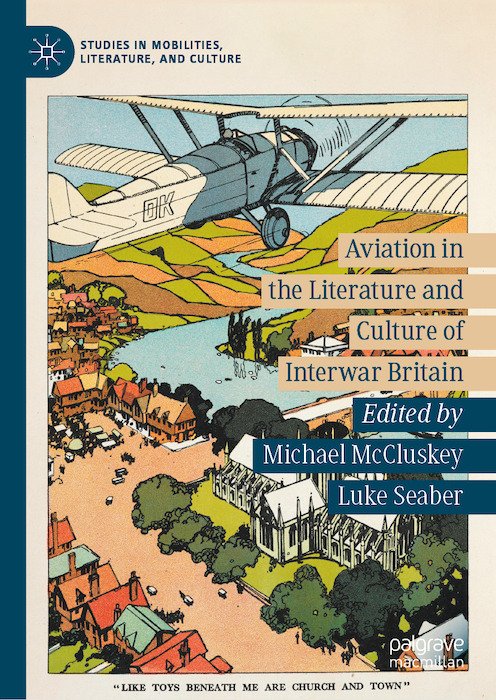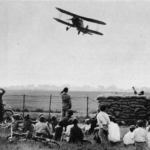
I’ve got a chapter entitled ‘Spectre and spectacle: mock air raids as aerial theatre in interwar Britain’ in a new Palgrave Macmillan collection just out, Aviation in the Literature and Culture of Interwar Britain, edited by Michael McCluskey and Luke Seaber. Here’s the abstract:
This chapter argues that aerial theatre, in the form of annual air displays at Hendon and on Empire Air Day, was used by the Royal Air Force (RAF) to generate a sensationally modern image of technological sublimity through violent spectacles of aerial warfare, including the performance of mock air raids. This was amplified by a second, incidental kind of aerial theatre, performed as part of Air Defence of Great Britain (ADGB) exercises and air raid precautions (ARP) drills in the form of mock air raids on British cities. These attracted curious and even excited audiences, conscious that they might be seeing previews of their own deaths. In combining spectre and spectacle, the RAF’s mock air raids underscore the ambivalent nature of airmindedness in interwar Britain.
It’s my third article pushing the aerial theatre concept, and it builds on both of its predecessors (‘The militarisation of aerial theatre’ and ‘The meaning of Hendon’). Here I narrow my focus specifically to mock battles, particularly those portraying air raids on civilian targets. But I also widen things out by drawing a distinction between what I call formal aerial theatre, meaning the sorts of air displays I usually write about such as the RAF Display (Hendon) and Empire Air Day, and incidental aerial theatre, in this case mainly meaning the annual ADGB exercises from 1927 onwards, as well as, beginning in 1936, ARP drills. ‘Incidental’, because while the point of these exercises was to determine the effectiveness of air and civil defences, they also involved RAF aircraft carrying out simulated attacks on actual urban targets in a very public and spectacular fashion. Those living in and around these targets were exposed to this aerial theatre whether they wanted to be or not. In fact, many people came out to watch these exercises as entertainment: in 1928, for example, ‘omnibuses took parties of sightseers to the hills around London’ to watch their city get theoretically pounded to rubble.1 Which I found quite fascinating, and so I wrote a chapter about it!
Beyond my own contribution, this looks like an amazing collection, and I can’t wait to read it. Here’s the publisher’s description:
Aviation in the Literature and Culture of Interwar Britain looks at the impact of aviation in Britain and beyond through the 1920s and 1930s. This book considers how in this period flying went from a weapon of war to an extensive industry that included civilian air travel, air mail delivery, flying shows and campaigns to create ‘airmindedness’. Essays look at these developments through the work of writers, filmmakers and flyers and examines the airminded modernism that marked this radical period. Its fourteen chapters include studies of texts by Virginia Woolf, George Orwell, Elizabeth Bowen, W.H. Auden, T.H. White and John Masefield; accounts of the annual RAF Display at Hendon and the Schneider Trophy; and the achievements of celebrity flyers such as Amy Johnson. This collection provides a fresh perspective on the interwar period by bringing analysis of aviation and airmindedness to the study of British literature, history, modernism, mobilities and the history of technology and transportation.
And just look at the table of contents:
- Michael McCluskey, ‘Introduction: airminded modernism’
- Allan Pero, ‘”A pinch of inquisitive pleasure”: Wyndham Lewis, the Great War and military surveillance’
- Luke Seaber, ‘”From this new culture of the air we finally see”: “groundmindedness” in the 1930s’
- Michael McCluskey, ‘Entering British airspace: aviation and film’
- Daniel Kilburn, ‘Flying blind: the formation of airmindedness from a pilot’s perspective’
- Robert Hemmings, ‘”Off the ground and through the looking-glass”: airliners, imagination and the construction of the modern air passenger’
- Nicola Darwood, ‘Flying dangerously: Elizabeth Bowen’s To the North‘
- Ann Rea, ‘”True blue heroines”: the 1930s aviatrix and eccentric colonial femininity’
- Guy Woodward, ‘”A solar emperor”: Robert Byron flies east’
- Rinni Haji Amran, ‘”The fundamental magic of flying”: changing perspectives in Anne Morrow Lindbergh’s North to the Orient and Virginia Woolf’s The Years and Between the Acts‘
- Brett Holman, ‘Spectre and spectacle: mock air raids as aerial theatre in interwar Britain’
- Jeremy R. Kinney, ‘Airminded nationalism: Great Britain and the Schneider Trophy competition’
- Dominic Dean, ‘When the wolves were flying: The Box of Delights and flight in 1930s children’s literature’
- Simon Machin, ‘”The Camels Are Coming”: W. E. Johns, Biggles, and T. E. Lawrence’s flight into the Air Force’
- Simon W. Goulding, ‘”Watch the skies!”: Guernica, Dresden and the Age of the Bomber in George Orwell and Rex Warner’
And for that matter, the index. Fabulous!
You can purchase Aviation in the Literature and Culture of Interwar Britain in hardcover or ebook editions direct from the publisher here. You can also buy individual chapters — mine is here. Unfortunately neither option is exactly cheap, but Palgrave do regularly offer deep discounts, so it’s worth keeping an eye out for their sales.
By the way, the gorgeous cover art is based on an illustration by Leslie Carr, originally from Cyril Hall, Motor and Plane (Glasgow, Blackie & Son, [1932]).
![]() This work is licensed under a Creative Commons Attribution-NonCommercial-NoDerivatives 4.0 International License.
Permissions beyond the scope of this license may be available at http://airminded.org/copyright/.
This work is licensed under a Creative Commons Attribution-NonCommercial-NoDerivatives 4.0 International License.
Permissions beyond the scope of this license may be available at http://airminded.org/copyright/.





‘Holman, Brett’ has five references in the Index! Terrific!
One of those is a self-reference, I must hasten to point out!